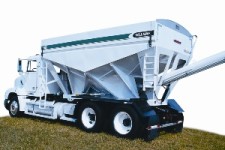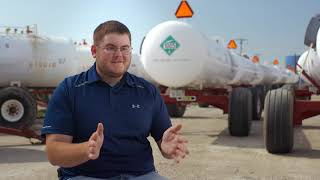Ready The Tenders

Fertilizer applicators didn’t put down as much nitrogen during the fall of ’08 as they would have liked, but tender manufacturers still saw plenty of action. The equipment demand might be especially surprising because wet harvests and a late fall in many locations have pushed sizeable applications to the spring.
Concerns about the economy also seem to be impacting fertilizer timing. “From a pure physiological standpoint, the global credit crisis has had an impact,” says David Webster, AGCO’s general sales and marketing manager Willmar/Spra-Coupe. “With the crisis being front-page news, it is impacting purchasing decisions even though the agricultural industry has been one of the least affected.” He says falling commodity prices have created a volatility — whether real or perceived — also have caused a number of growers to delay fertilizer application until the spring.
The KBH Corp. is one firm that’s seen good tender sales figures, but at presstime, sales staff there were reporting more uncertainty among growers compared to June’s buying enthusiasm, says Tim Tenhet, director of sales. “And retailers bought a lot of fertilizer at very high costs that they haven’t disposed of yet,” he says.
Michael Tibbett, sales manager of Adams Fertilizer, reported a better fall than he’s seen in two years. “People have cut back and extended the life of their equipment as far as they can, but it doesn’t last forever,” he says. “I think their equipment has just gotten to the point where they’ve got to replace it to keep up.”
He also sees retailer consolidation playing a role in tender demand. Some dealers are closing their smallest satellite stores — so a remaining site must get bigger. Then that site needs to add or update equipment, he says.
What’s catching the eye of dealers these days? Tenhet says hopper vibrators are gaining popularity. This option can preserve the life of a 304 steel bed.
What Buyers Want
AGCO’s Webster says buyers are also looking at tender compartment set-ups. “One of the things we are starting to see is an increase in variable-rate application — which makes the number and size of the compartments more critical in order to maximize efficiency.”
In the past, CropLife® has reported a move to larger rigs, and the trend continues to a degree. “Dealers are continually moving from 16-ton hitch-mounted units to 32-foot 25-ton units,” says Tenhet. In fact, his best-selling rig has been the firm’s 25-ton tender. Webster agrees: “Our 24-ton business has seen increases over the past year, but we still see the 16-ton business remaining strong, partly due to the ability to mount directly to a truck chassis vs. needing to be trailer-mounted.”
One proof of the health of the 16-ton market is Ag Systems’ recent introduction of its 1612 Rear Discharge Tender. The unit’s two-compartment hopper offers 5,500 cubic foot struck capacity.
Versatility is also a growing factor, in particular, extending to tender/nurse tank outfitting. “We are seeing more and more customers wanting the option to quick-change from a liquid tender to a dry tender using the same chassis,” says Ron Lager, sales manager with Precision Tank & Equipment. Those tanks are getting bigger, too, as he reports selling more 3,000-gallon and larger units. In fact, PT&E is offering a new 5,200-gallon nurse tank with multiple compartments.
About That Auger
Manufacturers continue to experiment with designs for the best ways to move fertilizer out of the tender — via rear discharge or side discharge. Tenhet says rear-discharge rigs continue to be strong sellers, though he had anticipated side units winning more of the market. “It’s not turning out that way. Some regions have turned to side augers, but the overwhelming market is still in rear-discharge units,” he says. But that’s not to say the logistical convenience of side augers is not in demand. Adams debuted its Double Side Shot Auger Tender Trailer in 2007 in response to customers’ calls for just such a rig.
As tender manufacturers gear up to meet the possible demand for their units, they do report a ray of sunshine in the uncertain economic picture: Stainless steel prices are coming down. “I’m feeling a lot better about the e-mails I’m getting from some of my vendors announcing that after the first of the year, I’m going to see a gradual decline in prices,” says Tibbett.





